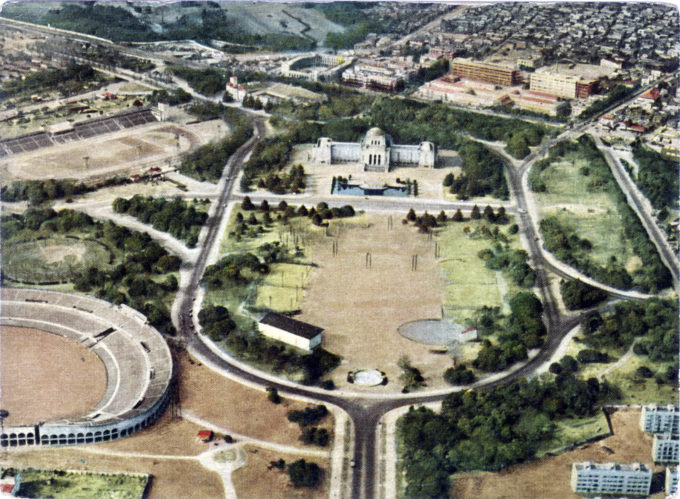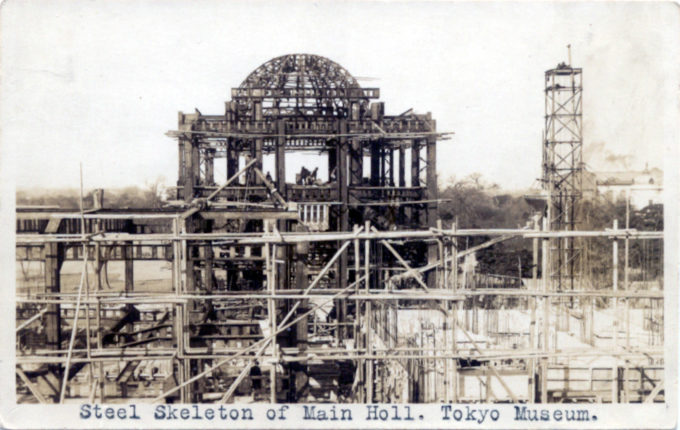See also:
Meiji Jingu (Shrine)
Meiji Jingu Base-Ball Ground, c. 1930
Meiji Jingu Outdoor Swimming Pool, Tokyo, c. 1935.
Emperor Meiji’s funeral hearse, 1912.

Map: Meiji Shrine Outer Garden, c. 1930. The Meiji Memorial Picture Gallery is at upper-center; the National Stadium and Meiji Jingu swimming pool are at upper left; Gaien Jingu baseball stadium is at lower-left. At right-center is Meiji Constitution Memorial Hall, where the Constitution of the Empire of Japan (1889-1945) was drafted.
“Outer Garden of Meiji-jingu Shrine is situated on the site of the former Aoyama Parade Ground and has an area of about 120 acres. It was here that the funeral ceremony of the Emperor Meiji was held in 1912, the site being thus held sacred.
“The work of laying out the [Outer Garden] grounds and founding Meiji-jingu Shrine was begun in 1915, and took about ten years to finish, the cost amounting to ¥8.500,000, almost the whole of which was collected by public subscription.
“The grounds contain a stadium, one of the largest and finest arenas in the Orient, capable of seating more than 55,000 people, a baseball ground, holding more than 60,000, a swimming pool, with accommodations for 15,000, and a wrestling ring, seating about 20,000 people. There is also the Memorial Picture Gallery dedicated to the Emperor Meiji and his consort, in which pictures illustrative of their lives are exhibited.”
– Japan: The Official Guide, Japan Government Railways, 1941
The Meiji Memorial Picture Gallery was completed in 1925 on the grounds of the Meiji Shrine Outer Garden [Meiji Jingu Gaien], between Aoyama and Sendagaya.
The gallery is a pictorial homage to Emperor Meiji and Empress Shoken to commemorate and display for the public a historical record depicting the the politics, culture, and manners of the Meiji era (1868-1912) when Japan underwent its rapid modernization. The original gallery was destroyed by fire during World War II and was replaced in 1958 by an identical structure.
The series of 80 paintings – the first 40 works are painted in a Japanese-style while the latter 40 are Western-style works – move in chronological order beginning with the turbulent era of transition from the Tokugawa Shogunate [bakufu] regime to the restoration of Imperial rule, the adoption of Western-style systems (legislative, judicial, civic, and military) including the promulgation of the Meiji Constitution, Japan’s establishment as a Great Power in the early 20th century and, finally, the death of Emperor Meiji in 1912.
– Wikipedia

Meiji Memorial Picture Gallery, c. 1960. “The Emperor’s Final Illness (July 1912).” In this portrait from the Picture Gallery, No. 79, people gather outside the Tokyo Imperial Palace to pray for Emperor Meiji’s recovery. The emperor would pass in September, 1912. (See below for a representative sampling of other artwork from the gallery.)
“[The] Meiji Shrine Memorial Art Gallery (Meiji Jingu Seitoku Kinen Kaigakan) was constructed as a mnemonic space, and that its construction concerned the making of history. The purpose of the gallery was to provide a historical narration of the Meiji period through 80 paintings depicting Emperor Meiji’s life.
“It took over 20 years from the initial planning of the gallery to its completion in 1936 and, throughout the course of its creation, different acts of remembering took place both inside and outside the space of the gallery.
“It was the lengthy process of gallery construction, rather than the place itself that shaped what was to be remembered. Historiographers and painters strove to portray ‘real’ history in the gallery’s paintings. Historiographers investigated historical facts and determined the gallery’s picture topics … For the painters, the challenge lay in determining ‘realistic’ styles of adequate to the representation of ‘real’ history.”
– “The Making of a Mnemonic Space: Meiji Shrine Memorial Art Gallery 1912-1936”, by Yoshiko Imaizumi, Japan Review No.23, 2011

Whole view of Meiji Park Outer Garden, c. 1935. The Meiji Memorial Picture Gallery is at upper-right. Below the Meiji Jingu baseball stadium (at center) is the Peeress’ School, relocated to Yotsuya in 1885 from Kanda. The school would later be merged with Gakushin, relocate to Meijiro and the property in the Outer Garden replaced after WWII by a the national rugby stadium. Meiji Jingu Stadium is one of the few professional stadiums still in existence where Babe Ruth played. In 1934, Ruth joined several other famous baseball players from the U.S., such as Lou Gehrig and Jimmie Foxx, in a 22-game tour of Japan.
“The Picture Gallery was designed by the architect Kobayashi Masatsu, and consisted of a narrow hall divided into East and West Wings, divided by a domed central entrance.
“In the East Wing, 40 Nihon-ga (Japanese-style) paintings, the style of painting that Emperor Meiji preferred,, document key events in his life from his birth in 1852 through to 1878.
“Quite appropriately, painting no. 41, the first of the Western-style oil paintings (Yo-ga), shows the Emperor receiving General U.S. Grant, former US President, who visited Tokyo on 3 July 1879.
“Why were photographs not used instead? Paintings lent themselves to depicting scenes in large format, in colour, and gave artists considerable artistic license. As John McGee suggested, the Gallery and its contents ‘echo Meiji-period tensions between Japan and the West, between feudalist tradition and industrialised society, between nationhood and empire.'”
– Japan on Display: Photography and the Emperor, by Morris Low, 2006
Representative Sampling of Artwork in the Picture Gallery
- #1 The Birth of Emperor Meiji (Nov. 3, 1852).
-
#2
The Rites of Growth (1860).
-
#4
Accession to the Throne (1867).
- #14 Visiting Osaka, (1868).
- No. 42: The Emperor inspecting the farmer-soldiers tondenhei) during the imperial tour of Hokkaido (September 1, 1881).
- No. 56: Opening of the Imperial Diet ( November 29, 1890), marking the beginning of rule under the Meiji Constitution.
- No. 73: The Triumphal Grand Naval Review (Oct. 23 1905), following Japan’s victory over Russia.
- No. 80: The Imperial Funeral (Sept. 14, 1912). After a ceremony at the Aoyama Funeral Pavilion in Tokyo on 13 September, the Emperor’s coffin was taken by train to Kyoto, before being conveyed to Fushimi Momoyama no Misasagi.














Pingback: Meiji Jingu Base-Ball Ground, c. 1930. | Old Tokyo
Pingback: Meiji Japan • Japan Technology News
Pingback: Meiji Jingu Outdoor Swimming Pool, Tokyo, c. 1935. | Old Tokyo
Pingback: Emperor Meiji at the Grand Fleet Review, 1905. | Old Tokyo
Pingback: Emperor Meiji meets General Grant, 1879. | Old Tokyo
Pingback: Dedication of Meiji Shrine, Tokyo, 1920. | Old Tokyo
Pingback: “Emperor of Japan”, c. 1905. | Old TokyoOld Tokyo
Pingback: Meiji Jingu (Shrine), Tokyo. | Old TokyoOld Tokyo
Pingback: Hoteiya department store, Shinjuku, Tokyo, 1929. | Old TokyoOld Tokyo
Pingback: Meiji Jingu Base-Ball Ground, c. 1930. | Old TokyoOld Tokyo